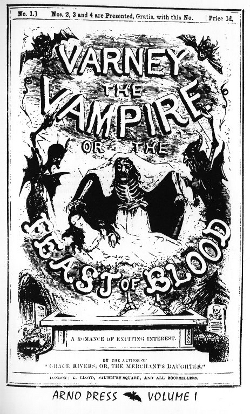
"The figure turns half round, and the light falls upon its face. It is perfectly white — perfectly bloodless. The eyes look like polished tin; the lips are drawn back, and the principal feature next to those dreadful eyes is the teeth — the fearful looking teeth"
—From Chapter I
|
Varney the Vampire, or, The Feast of Blood by James Malcolm Rymer[1] was one of the original vampire penny dreadfuls (c. 1845-47).
It's a bodice-ripper with 220 chapters[2] of riveting Victorian Gothic horror and one hell of an ending!
Varney was an enormous influence on later vampire literature, such as Dracula (1897) by Bram Stoker. Many of today's standard vampire tropes originated with Varney: Varney has fangs, leaves two puncture wounds on the necks of his victims, has hypnotic powers, and has superhuman strength. Unlike later fictional vampires, he is able to go about in daylight and has no particular fear or loathing of crosses or garlic. He can eat and drink in human fashion as a form of disguise, but he points out that human food and drink do not agree with him. His vampirism seems to be a fit that comes on him when his vital energy begins to run low; he is a regular person between feedings.
Varney is also the first example of the "sympathetic vampire," a vampire who hates his night job but is a slave to it nevertheless — a theme which has become popular in modern vampire fiction. Varney's conflict eventually leads him to drastic action.
The entire text of Varney the Vampire is available for free online.
Provides examples of:[]
- All Girls Want Bad Boys: How Mrs. Bannerworth happened to choose ne'er-do-well Mr. Bannerworth as a husband.
- Chuck Cunningham Syndrome: At the beginning of the novel, the Bannerworth family has three children — Henry, Flora, and George — but George is never mentioned again after Chapter 36.
- Doorstopper: The complete printed text runs on (and on and on) for some 868 double-column pages.
- Either or Title
- Fangs Are Evil: Varney was the first fictional vampire to have fangs.
- I Do Not Drink Wine: The fact that Varney doesn't drink wine provides a clue early on that he is a vampire.
- Insane Admiral: Admiral Bell, while protective of his family and a generally decent guy, acts like a complete lunatic in most situations.
- Kill It with Fire: Necessary to destroy a vampire.
- Our Vampires Are Different: The rules of vampirism are quite different both from legend and modern vampire fiction. In particular, the idea that vampires can be healed by moonlight is almost never used in later works.
- Phantasy Spelling: "Vampire" is sometimes spelled "vampyre." Justified, as the word was a neologism to English at the time, and had no established spelling or pronunciation.
- Skepticism Failure: Chillingworth plays this role, both with regard to the vampire and the literal interpretation of the Bible
- Trope Makers: It introduced most of the modern vampire concepts like hypnotic ability, super strength, puncture wounds from fang bites, and going crazy if a long time pass without feeding. Also a reluctant one. Stoker was inspired quite a bit by it.
- Writers Cannot Do Math: A sort of meta example: a bunch of chapters are misnumbered because the writer lost count.
- You Sexy Beast: Varney.
- ↑ published anonymously and attributed by some scholars to Thomas Preskett Prest
- ↑ nearly 667,000 words (longer than War and Peace!)
